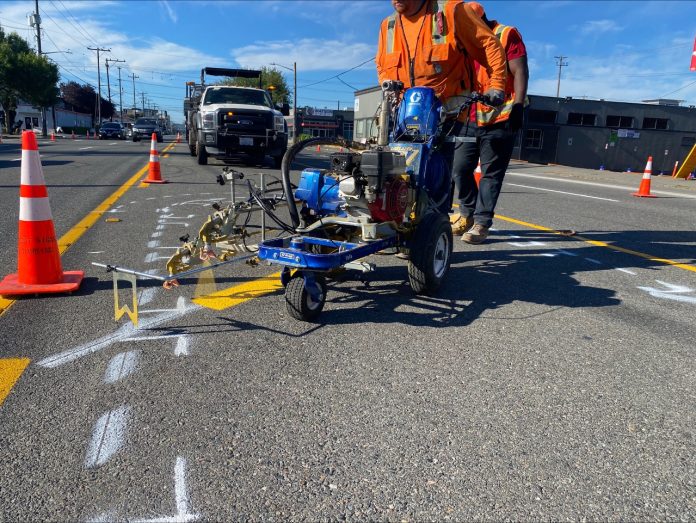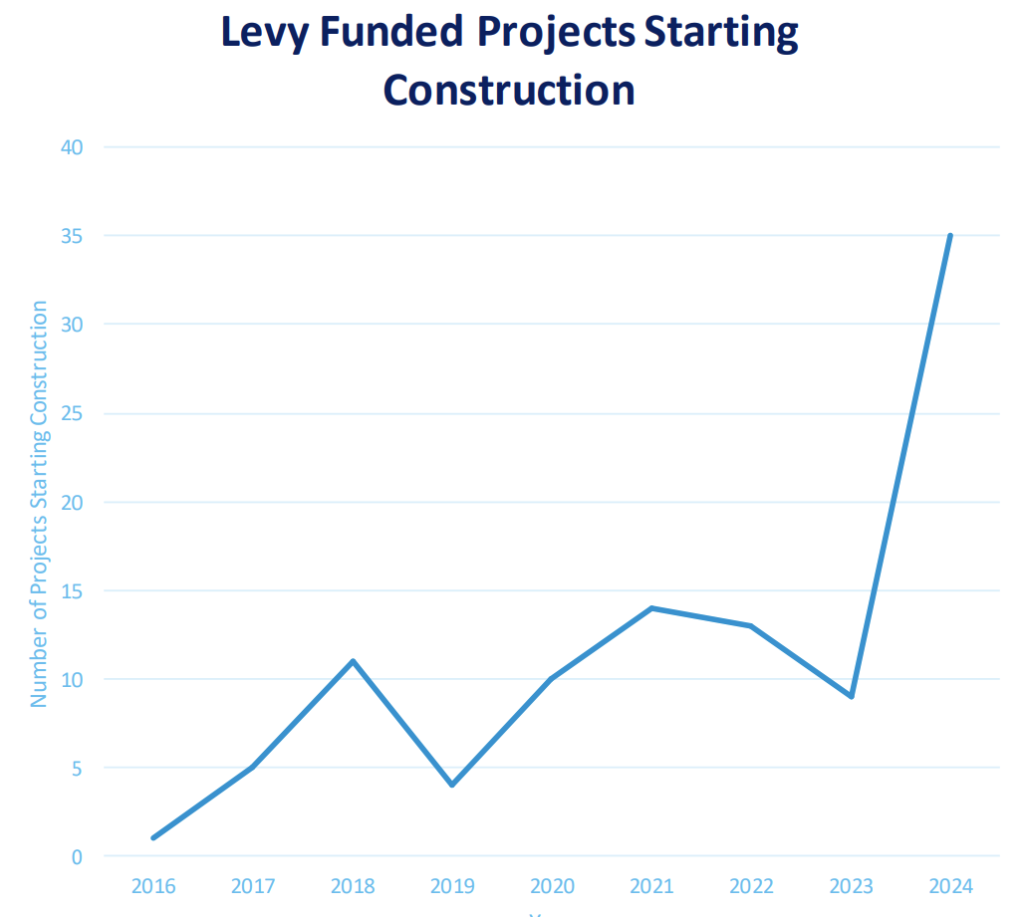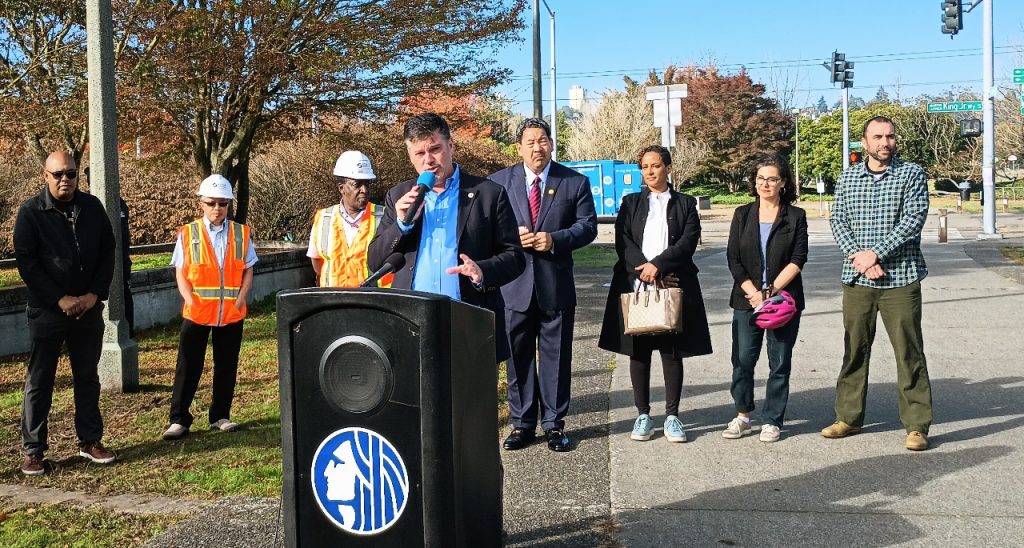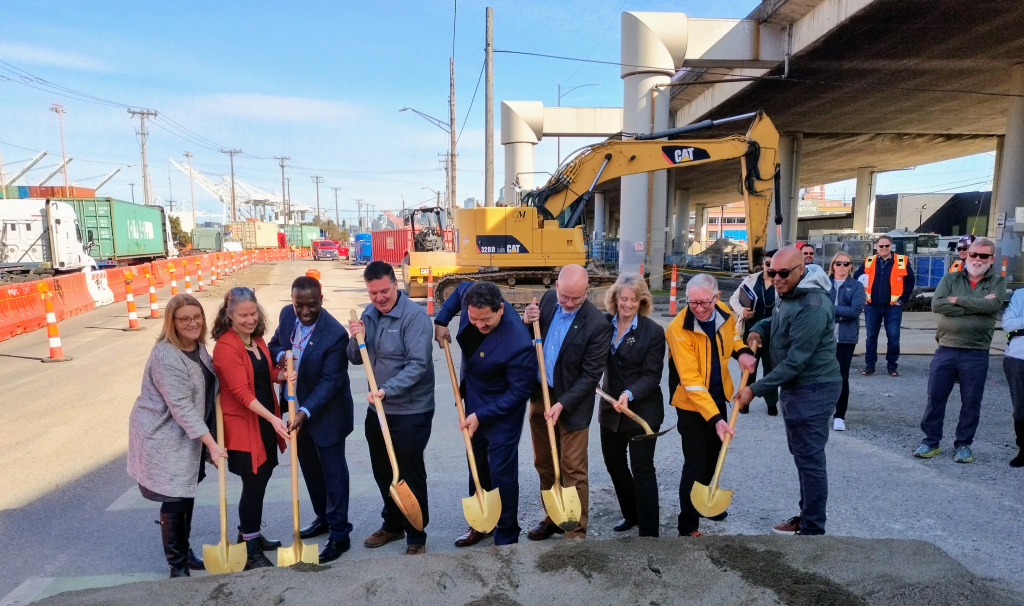
With a $1.45 billion transportation levy proposal in front of the Seattle City Council, attention has turned toward future investments and what they mean for the city’s collective mobility priorities. But behind the scenes, the Seattle Department of Transportation (SDOT) is quietly getting projects out the door in what is on track to be the busiest year for transportation projects in Seattle, ever. The goal is to finish strong on the current Move Seattle Levy, approved in 2015, and make a compelling case for the next transportation levy, which makes up around a third of SDOT’s entire budget. But in so doing, SDOT is also showing how the department has evolved in the past nine years.
So far this year, SDOT has solicited bids from contractors on a huge array of projects, including nearly 10 seismic upgrades on bridges around the city, sidewalk projects, crossing improvements, and a number of big projects that have been in the pipeline for a long time — including the RapidRide J corridor project, the critical first phase of the Beacon Hill bike route, the next phase of Rainier Avenue transit lanes, and upgrades for King County Metro’s Route 40.
All of these projects are on different construction timelines, and different levels of visibility for everyday city residents, but they’re all part of the push at the end of the levy to get things out the door.
“The average number of construction starts we’ve had over the last few years, for contracted projects, is one a month,” SDOT Director Greg Spotts, who has been heading the department since fall of 2022, told The Urbanist. “January, February, March and April, we’ve had eight, so we’ve doubled it to two a month. That’s a step change. That’s not a incremental change. And I’m very proud of the team for doing that. And I think the pace is going to increase even further, in terms of the number of construction starts a month, most of which are levy funded projects, all the way through the end of this year.”

Spotts touts the project delivery machine that the department has been able to create in recent years as producing the results that Seattle residents are seeing in their neighborhoods, something that also extends to smaller projects, delivered by SDOT’s own crews: things like new crosswalks and all-way stops installed near many of Seattle’s elementary schools in the past year, and the pilot bike lane barriers being rolled out in existing protected bike lanes around the city.
“I have made a very significant effort to increase the tempo of how we get these projects through design, how we conduct community outreach in a way that’s efficient for us and the community members, and how we make decisions and confidently carry on and make the next round of decisions to get things into construction,” Spotts said.

But a big part of the 2024 push is attributable to the 2015 levy’s ambitious goals, which pushed the department to continually look for new resources to get closer. Even if Seattle wasn’t able to deliver seven full transit corridor projects, due in part to a lack of federal matching dollars, having that goal ensured that upgrades to the Route 40, 44, and 48 all moved forward in some capacity. Even though the city won’t hit its goal of implementing 110 miles of bike infrastructure, projects like the Georgetown-to-Downtown bike route likely wouldn’t have happened on their current timelines without that goal.
“There’s a pretty broad consensus within SDOT that we got off to a slow start on the Levy to Move Seattle, and perhaps one of the reasons why was there was kind of a assumption that existing staff could do the job. And if you just almost tripled the size of the levy, it would have made more common sense that you need to staff up,” Spotts said.
In many ways, in the area of project delivery, today’s Seattle Department of Transportation is the one that voters were promised in 2015… it just took several more years than initially expected to get there.
“SDOT’s quite a bit larger in headcount than we were in 2015-2016. And we have a very sophisticated capital projects division and project development division, who are, not just larger, but we’ve actually developed talent during this period,” Spotts continued. “We have people who are much more experienced, who are experienced working with each other; we’ve refined internal systems for collaboration and coordination. So I really believe that we have a capital projects delivery machine that didn’t exist at nearly this throughput capacity back when the Levy to Move Seattle was started.”

But Mayor Bruce Harrell’s levy renewal proposal, getting its first public hearing today at the Seattle City Council, is less ambitious in its goals and includes fewer guardrails around what specifically the city is expected to spend money on. When Move Seattle included baseline funding requirements in the city’s budget for its three main categories — safe routes, congestion relief, and maintenance and repair — this levy only specifies anticipated spending levels, no minimum requirements. Project lists are currently fairly vague, though there are some specific commitments, including one to construct 250 blocks of new sidewalks by the midpoint of the levy in 2029.
“One of the lessons we learned from the Levy to Move Seattle was to be more cautious about making early commitments that rely on optimistic assumptions about how much grant funding we will receive,” SDOT spokesperson Ethan Bergerson told The Urbanist. Making fewer concrete commitments is a way to ensure the department doesn’t go over its skis, but it also paints a less compelling vision for the city’s transportation vision, and is one factor behind a large push by transportation advocates to make the next levy much bigger and more ambitious.
And then there’s the issue of what happens later this year, with all of these projects out the door and the fate of the next levy very much up-in-the-air. Will a lack of projects in the pipeline lead to a similar lag in project delivery like the city saw at the start of Move Seattle? Spotts says no, adding that they’re thinking differently about this than they have in the past.
“We’re exploring whether there’s some projects that the current levy can’t afford to construct, but could afford to complete design on,” Spotts said. “We want to have basket of projects that could be shovel ready for the next levy.” The department has already received grant funding for two corridor repaving projects, one on E Marginal Way S north of the South Park Bridge, and another on Roosevelt Way NE from NE 92 St to Pinehurst Way NE. Those projects, expected to have multimodal components, are set to be the first to move forward under the new levy.
Spotts also touts the planned goal of protecting 30% of the existing bike lanes in the city with more substantive barriers. “We think we could take that Better Bike Barrier program, and scale it with funds from the new levy. We could be dropping Toronto [style] barriers into existing bike lanes that currently have the paint and post, and that’s something we can do with city forces.”
What SDOT seems to be showing the city in 2024 is that the department is prepared to hit the ground running if voters approve the next levy. But what’s missing is how that levy will actually push the City towards achieving a collective vision that can endure no matter who’s in the Mayor’s Office or at the top of SDOT.
The Seattle City Council is holding the first of two public hearings on Mayor Bruce Harrell’s transportation levy proposal today at 4:30pm. You can sign up to testify virtually starting at 3:30pm, or submit written comments anytime, here.
For more information, The Urbanist has analyzed the mayor’s levy proposal in a series of articles:
- “A Deep Dive on the 15 Corridor Upgrades in Seattle’s Draft Transportation Levy“
- “Seattle Gives Up on Bike Network Expansion Goals in Draft Transportation Levy“
- “Seattle Levy Proposal Keeps Modest Pace of Building New Sidewalks“
- “Seattle Levy Proposal Lowers the Bar on Public Transit Investments“
- “Seattle Voters on Board with Big Transportation Levy, Poll Shows“
- “Harrell Adds $100 Million to Transportation Levy Proposal, Sends to Council“
- “Mobility Advocates Find Support for Bigger Levy in Poll, Council Deliberates“
Ryan Packer has been writing for The Urbanist since 2015, and currently reports full-time as Contributing Editor. Their beats are transportation, land use, public space, traffic safety, and obscure community meetings. Packer has also reported for other regional outlets including BikePortland, Seattle Met, and PubliCola. They live in the Capitol Hill neighborhood of Seattle.

